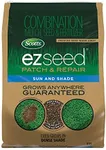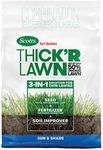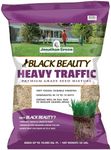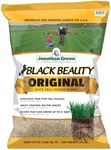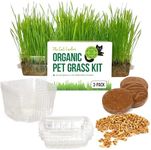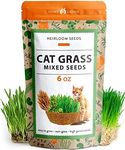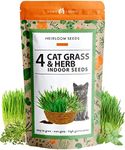Buying Guide for the Best Lawn Seeds
Choosing the right lawn seeds is crucial for achieving a lush, green lawn that meets your specific needs. Whether you're looking to create a durable play area for kids, a beautiful garden centerpiece, or a low-maintenance yard, understanding the different types of lawn seeds and their characteristics will help you make an informed decision. Consider factors such as climate, soil type, sunlight exposure, and intended use to find the best fit for your lawn.Grass TypeGrass type refers to the species of grass seeds you choose for your lawn. This is important because different grass types have varying characteristics such as growth habits, texture, and tolerance to environmental conditions. Common types include Kentucky Bluegrass, Fescue, and Bermuda grass. Kentucky Bluegrass is known for its rich color and fine texture, making it ideal for cooler climates. Fescue is versatile and can thrive in both sun and shade, while Bermuda grass is durable and heat-tolerant, perfect for warmer regions. Choose a grass type that matches your climate and lawn usage.
Sunlight RequirementsSunlight requirements indicate how much sun the grass needs to grow properly. This is crucial because planting a grass type that doesn't match your lawn's sunlight exposure can lead to poor growth and patchy areas. Grass seeds are typically categorized into full sun, partial sun, and shade-tolerant varieties. Full sun grasses need at least 6 hours of direct sunlight daily, partial sun grasses can thrive with 3-6 hours, and shade-tolerant grasses can grow with less than 3 hours of sunlight. Assess your lawn's sunlight exposure and choose seeds accordingly.
Soil Type CompatibilitySoil type compatibility refers to how well the grass seeds will grow in your specific soil conditions. This is important because different grasses have varying nutrient and drainage needs. Common soil types include sandy, clay, and loamy soils. Sandy soils drain quickly and may require drought-tolerant grasses, clay soils retain moisture and may need grasses that can handle wet conditions, while loamy soils are well-balanced and suitable for most grass types. Test your soil and select seeds that are compatible with its characteristics.
Maintenance LevelMaintenance level indicates how much care and effort is required to keep the lawn healthy and attractive. This is important because some grasses need frequent mowing, watering, and fertilizing, while others are more low-maintenance. High-maintenance grasses like Kentucky Bluegrass require regular upkeep to stay lush, whereas low-maintenance options like Fescue or Zoysia grass need less frequent care. Consider your willingness and ability to maintain your lawn when choosing seeds.
Traffic ToleranceTraffic tolerance refers to how well the grass can withstand foot traffic and other physical activities. This is important if your lawn will be used for sports, play areas, or frequent gatherings. High traffic-tolerant grasses like Bermuda and Zoysia are durable and can recover quickly from wear and tear, making them ideal for active lawns. If your lawn will have minimal foot traffic, you can opt for more delicate grasses like Kentucky Bluegrass. Match the traffic tolerance of the grass to your lawn's intended use.
Growth RateGrowth rate indicates how quickly the grass will establish and fill in your lawn. This is important for planning how soon you want a fully grown lawn. Fast-growing grasses like Ryegrass can establish quickly, making them suitable for temporary lawns or overseeding. Slower-growing grasses like Fescue take longer to mature but often result in a more durable and long-lasting lawn. Consider your timeline and patience for lawn establishment when selecting seeds.



